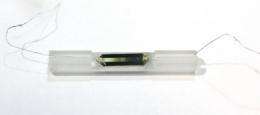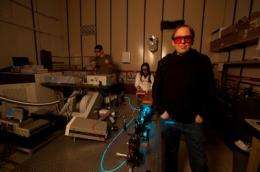Computer memory takes a spin: Physicists read data after storing them in atomic nuclei for 112 seconds

University of Utah physicists stored information for 112 seconds in what may become the world's tiniest computer memory: magnetic "spins" in the centers or nuclei of atoms. Then the physicists retrieved and read the data electronically – a big step toward using the new kind of memory for both faster conventional and superfast "quantum" computers.
"The length of spin memory we observed is more than adequate to create memories for computers," says Christoph Boehme (pronounced Boo-meh), an associate professor of physics and senior author of the new study, published Friday, Dec. 17 in the journal Science. "It's a completely new way of storing and reading information."
However, some big technical hurdles remain: the nuclear spin storage-and-read-out apparatus works only at 3.2 degrees Kelvin, or slightly above absolute zero – the temperature at which atoms almost freeze to a standstill, and only can jiggle a little bit. And the apparatus must be surrounded by powerful magnetic fields roughly 200,000 times stronger than Earth's.
"Yes, you could immediately build a memory chip this way, but do you want a computer that has to be operated at 454 degrees below zero Fahrenheit and in a big national magnetic laboratory environment?" Boehme says. "First we want to learn how to do it at higher temperatures, which are more practical for a device, and without these strong magnetic fields to align the spins."
As for obtaining an electrical readout of data held within atomic nuclei, "nobody has done this before," he adds.
Two years ago, another group of scientists reported storing so-called quantum data for two seconds within atomic nuclei, but they did not read it electronically, as Boehme and colleagues did in the new study, which used classical data (0 or 1) rather than quantum data (0 and 1 simultaneously). The technique was developed in a 2006 study by Boehme, who showed it was feasible to read data stored in the net magnetic spin of 10,000 electrons in phosphorus atoms embedded in a silicon semiconductor.
The new study puts together nuclear storage of data with an electrical readout of that data, and "that's what's new," Boehme says.
The study was led by Boehme and first author Dane McCamey, a former research assistant professor of physics at the University of Utah and still an adjunct assistant professor. His main affiliation now is with the University of Sydney. Other co-authors were Hans van Tol of the National High Magnetic Field Laboratory in Tallahassee, Fla., and Gavin Morley of University College London.
The study was funded by the National High Magnetic Field Laboratory, the National Science Foundation, the Australian Research Council, Britain's Engineering and Physical Sciences Research Council and the Royal Commission for the Exhibition of 1851, a British funding agency led by Prince Philip.

Of Electronic and Spintronic Memories
Modern computers are electronic, meaning that information is processed and stored by flowing electricity in the form of electrons, which are negatively charged subatomic particles that orbit the nucleus of each atom. Transistors in computers are electrical switches that store data as "bits" in which "off" (no electrical charge) and "on" (charge is present) represent one bit of information: either 0 or 1.
Quantum computers – a yet-unrealized goal – would run on the odd principles of quantum mechanics, in which the smallest particles of light and matter can be in different places at the same time. In a quantum computer, one quantum bit or "qubit" could be both 0 and 1 at the same time. That means quantum computers theoretically could be billions of times faster than conventional computers.
McCamey says a memory made of silicon "doped" with phosphorus atoms could be used in both conventional electronic computers and in quantum computers in which data is stored not by "on" or "off" electrical charges, but by "up" or "down" magnetic spins in the nuclei of phosphorus atoms.
Externally applied electric fields would be used to read and process the data stored as "spins" – just what McCamey, Boehme and colleagues did in their latest study. By demonstrating an ability to read data stored in nuclear spins, the physicists took a key step in linking spin to conventional electronics – a field called spintronics.
Spin is an unfamiliar concept to comprehend. A simplified way to describe spin is to imagine that each particle – like an electron or proton in an atom – contains a tiny bar magnet, like a compass needle, that points either up or down to represent the particle's spin. Down and up can represent 0 and 1 in a spin-based quantum computer.
Boehme says the spins of atoms' nuclei are better for storing information than the spin of electrons. That's because electron spin orientations have short lifetimes because spins are easily changed by nearby electrons and the temperature within atoms.
In contrast, "the nucleus sits in the middle of an atom and its spin isn't messed with by what's going on in the clouds of electrons around the nucleus," McCamey says. "Nuclei experience nearly perfect solitude. That's why nuclei are a good place to store information magnetically. Nuclear spins where we store information have extremely long storage times before the information decays."
The average 112 second storage time in the new study may not seem long, but Boehme says the dynamic random access memory (DRAM) in a modern PC or laptop stores information for just milliseconds (thousandths of a second). The information must be repeatedly refreshed, which is how computer memory is maintained, he adds.
How to Store and Then Read Data in the Spins of Atomic Nuclei
For the experiments, McCamey, Boehme and colleagues used a thin, phosphorus-doped silicon wafer measuring 1 millimeter square, and placed electrical contacts on it. The device was inside a supercold container, and surrounded by intense magnetic fields. Wires connected the device to a current source and an oscilloscope to record data.
The physicists used powerful magnetic fields of 8.59 Tesla to align the spins of phosphorus electrons. That's 200,000 times stronger than Earth's magnetic field.
Then, pulses of near-terahertz electromagnetic waves were used to "write" up or down spins onto electrons orbiting phosphorus atoms. Next, FM-range radio waves were used to take the spin data stored in the electrons and write it onto the phosphorus nuclei.
Later, other pulses of near-terahertz waves were used to transfer the nuclear spin information back into the orbiting electrons, and trigger the readout process. The readout is produced because the electrons' spins are converted into variations in electrical current.
"We read the spin of the nuclei in the reverse of the way we write information," Boehme says. "We have a mechanism that turns electron spin into a current."
Summarizing the process, Boehme says, "We basically wrote 1 in atoms' nuclei. We have shown we can write and read [spin data in nuclei]," and shown that the information can be repeatedly read from the nuclei for an average of 112 seconds before all the phosphorus nuclei lose their spin information. In a much shorter time, the physicists read and reread the same nuclear spin data 2,000 times, showing the act of reading the spin data doesn't destroy it, making the memory reliable, Boehme says.
Reading out the data stored as spin involved reading the collective spins of a large number of nuclei and electrons, Boehme says. That will work for classical computers, but not for quantum computers, for which readouts must be able to discern the spins of single nuclei, he adds. Boehme hopes that can be achieved within a few years.
Provided by University of Utah


















